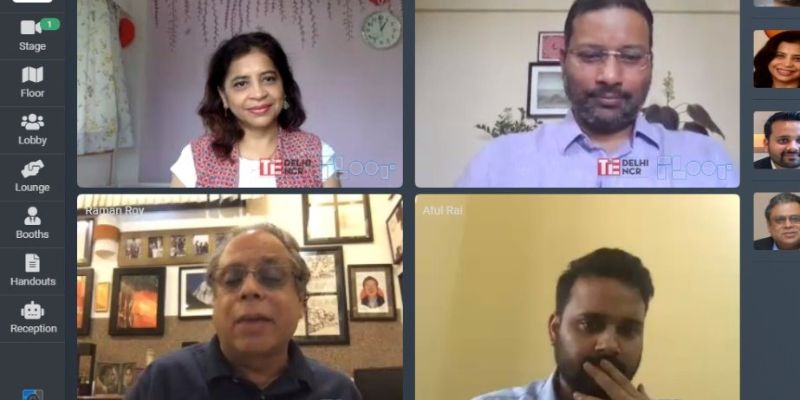'Google, Facebook are walled gardens for advertisers'
The world of advertising from the digital perspective is becoming a trading platform. Data is the gold mine and advertisers want tech to help them understand publishers that give their brands visibility. However, digital technology gives advertisers something more than visibility; it allows them to study their audience better because the consumer leaves a digital foot print.

C1X is one of the players in this evolving digital advertising landscape. This marketing technology company raised $5.1 million from UTEC Edge Capital, in 2015, and recently closed a Series-A round of $8.5 million from Venture Labo and UTEC-Japan. Rammohan Sundaram, MD & SVP for the APMEA region for C1X Inc, caught up with YourStory and spoke about the changing trends in advertising and media buying. According to research agency eMarketer, the current global digital adspend amounts to $100 billion, and this will double by 2020.
With the US and Europe being the markets for digital spending, Rammohan expresses his views on how India could change with the growth of the space. Here are some excerpts of the interview:
1. How has media planning changed for publishers, agencies and brands? It was relationship-driven, but has digital changed that dynamic?
RS: What has become a habit takes time and conscious effort to change, so if you ask me whether media planning has changed, then to an extent, it has. But a lot of it continues to be how it used to be before- relationships-driven. It is not conducive for the ecosystem to not change with the moving dynamics in the digital space. With the dynamic changes in the space, I feel that what get hammered out as priorities tend to change because there is no other way to execute campaigns.
What I mean by this is that Google and Facebook to me are walled gardens, and these walled gardens have a way of operating. So if things have to be done programmatically here on these platforms, then it does get done. However, the same logic may not apply to other properties that media buying agencies would buy, which is where the gap comes in.
While the value that a Google or a Facebook delivers is incredible, the world outside of that is equally powerful, and so the way media planning and buying is done will change outside of the walled gardens, because everything is transparent and easy to operate in a programmatic environment. So it will eventually change across digital, but to your question as to whether it has changed fully, then the answer is no, it is still a work in progress.
2. Digital publishing has gone programmatic for some time now, yet brands are still going after print and TV for mind share in developing markets; when do you think the needle will move towards digital?
RS: Programmatic is still new on the adoption curve outside of the US and UK, so like I mentioned, it is still a work in progress in the other markets of the world. But to say that brands will totally stop using TV and Print for consumer mind share purposes would be a fallacy. Consumption of media (TV and Print) will change, and there will be movement to various other devices, but brands will continue to use them for recall purposes.
For brands to know the power of the digital space outside of acquisition and reach mechanisms, the support partners have to play the role of educating them on how to leverage the opportunity, whether through content or search or display advertising or through social, and that is where priorities and business objectives play an important role. A marketer is always on his/her toes to get business objectives met and that is how it should be. However, if the agency or platform partners like us can’t show the value that other opportunities bring in outside of print and TV, the confidence levels will never soar. It is a constant endeavour to excel and partner the brand to make sure that the digital pie increases.
3. Please talk about your company, its early years and how it evolved into a programmatic engine provider that uses deep insights to help brands get the right publishing space?
RS: C1X is a full stack adtech platform, offering a range of services including a Demand Side Platform (DSP), Supply Side Platform (SPP) and E-commerce Solutions, including Saas, in an exchange environment, bringing the premium inventory on board by showcasing the audiences of various publishers, who are either plugged in directly or through other sources. Through data sciences, our engine gives us an edge in terms of audience segmentation and at the same time, brings in transparency for the advertiser to ensure that he/she gets the right value for every dollar that is spent on advertising efforts.
4. What are your thoughts on the advertising industry in different markets and how publishers should work with brands in the digital world?
RS: Everything is going the programmatic route, and it is just a matter of time before everyone either embraces it or is left behind. While the adoption in the US for DSPs and SSPs is high, it is companies like ours that have a full stack solution capable of enabling both sides of the coin to integrate seamlessly, which in this case are the buy side and the sell side.
So the US is way ahead and we are all playing catch up; Singapore and SEA are very close, with brands wanting transparency in every dollar that is getting spent. However, we see a lot of ATDs (Agency Trading Desks) coming up given that the agency wants to keep control of the demand because they still don’t understand that we are in no way a threat to them; we are actually enablers and partners who will only help them in scaling up. The ones who understand, work with us directly; for the others, deal ids come into play and we are left with little choice but to work with the ATDs. All of this is changing at a fast clip and publishers are clearly seeing the benefit of working with partners like us who are transparent, which is why, just in the last four weeks, we have onboarded over 250 publishers catering to global demand coming directly or through pipes that are integrated with DSPs on our platform.
5. How has your company grown? Talk me through some of the brand partnerships and the engagements that you have with them.
RS: Our company has grown exponentially, and being the only differentiated product has been validated with the kind of VCs who have come on board in our Series B round after just two and a half years of our existence. Our partnerships with some of the demand partners like MediaMath are deep and we are scaling the story in other emerging markets. We have just closed on our senior hires for MEA, and will soon announce our APAC lead in this regard. We don’t do brand partnerships; brands work with us, but we are a MarTech platform, and anyone who is looking for audience science, data pooling, targeting, transparency and customisation works with us. For example, our e-commerce solution has been adopted by Shopclues, and we are looking at expanding that horizon for a lot of companies across the region.
6. Talk about your team. As you are a technology company at heart, how does one mix the best sales and marketing process with technology/analytics as a core service?
RS: We are very clear about who we are. We are a Marketing Technology company. Our core technology helps marketers solve all the problems, so anyone who is in the digital space and understands media and platforms gels very well within the organisation. And that is exactly how we are hiring our people across all sales functions globally, and especially in emerging markets in APAC and MEA.
Sales teams are well equipped with the product offering, and at the core of the offering is automation, seamless and agnostic in nature. That way, it helps the sales teams know just the core aspects of the product offerings because everything else from there on can be customised, so we will have no issues for teams to blend with product and engineering. We have key people interfaces that take the market needs to engineering and that comes from the sales teams on the ground if there is a need for any such tweaks or specific requirements for different markets.
7. Tell us about your founding team and how you guys got together to make this happen?
RS: I have known Mukundu for over 15 years and Dan for almost five. They had gotten together to build this story, and in the last two and a half years, have built a world class product. Mukundu, our founder and CEO, focuses on all the aspects of product and engineering, and while Dan handles all investor relations, strategy, product and growth. So when we got talking a while back, I was obviously very kicked about what they were building, but gave it time so that there was clarity and no overlap in roles, given that I have had experience building organisations as a founder in the past. So we clearly spelt out how we would want to drive the business, and so revenue, sales strategy, global expansion, partnerships and market feedback for product development came my way.








